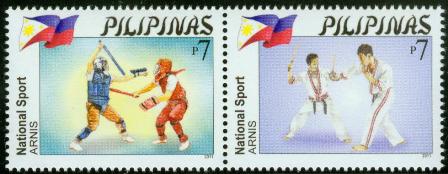2011, May 23. Arnis, National Sport
Litho Offset. Amstar Company, Inc. Perf. 14.
Se-tenant Pairs, Sheets of 40 (4 x 10)


Se-tenant Pairs (35,000)
7p Arnis (Colorful uniform)
7p Arnis (White uniform)
28p Souvenir Sheets of Four (5,000)
First Day Cover: Manila

ARNIS – NATIONAL SPORT
Filipino Martial Arts (FMA) refers to ancient and newer fighting methods devised in the Philippines, the most popular of which are known as Arnis/Eskrima/Kali. The intrinsic need for self-preservation was the genesis of these systems. Throughout the ages, invaders and evolving local conflict imposed new dynamics for combat in the islands now making up the Philippines. The Filipino people developed battle skills as a direct result of an appreciation of their ever-changing circumstances. They learned often out of necessity how to prioritize, allocate and utilize common resources in combative situations. Filipinos have been heavily influenced by a phenomenon of cultural and linguistic mixture. Some of the specific mechanisms responsible for cultural and martial change extended from phenomena such as war, political and social systems, technology, trade and of course, simple practicality.
Filipino martial arts have seen an increase in prominence due to several Hollywood movies and the teachings of modern masters. Filipino martial artists are noted for their ability to fight with weapons or empty hands interchangeably and their ability to turn ordinary household items into lethal weapons. Weapons-training takes precedence because they give an edge in real fights, gears students to psychologically face armed opponents, and any object that can be picked up can be used as a weapon using FMA techniques. Empty hands training is then taught as the stick is merely an extension of the hand.
What separates Filipino Martial Arts from other weapon-based martial arts like Japanese Kendo & Kenjutsu, European Fencing and traditional Chinese Martial arts that teach the usage of classical Chinese weapons is that FMA teaches weapon use that is practical today: how to use and deal with weapons that one can actually encounter in the streets and how to turn ordinary items into improvised weapons. No one walks around with sabers, katanas or jians anymore, but knives, machetes and clubs are still among commonly encountered weapons on the street and in the field, thus making FMA very practical and geared towards military and street fighting.
Traditional weaponry varies in design, size, weight, materials and usage but because of the similarity of techniques and that the human being can move in only so many ways, any object that can be picked up can be turned into a weapon by a Filipino martial artist as a force multiplier. (http://en.wikipedia.org/wiki/Filipino_martial_arts)
-
Sports
-
Flags